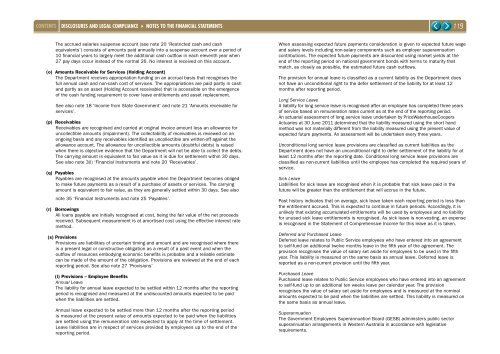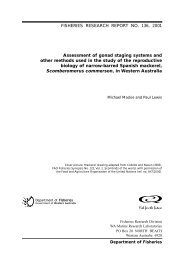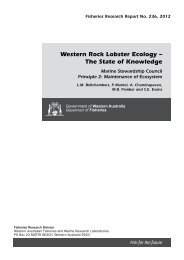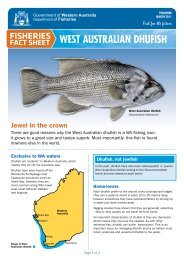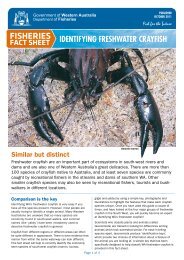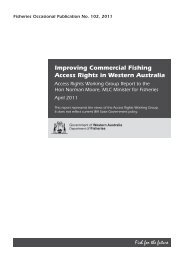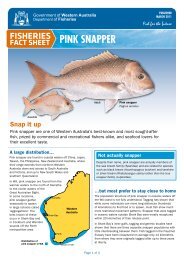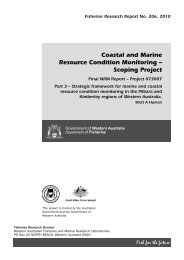DEPARTMENT OF FISHERIES ANNUAL REPORT TO THE ...
DEPARTMENT OF FISHERIES ANNUAL REPORT TO THE ...
DEPARTMENT OF FISHERIES ANNUAL REPORT TO THE ...
You also want an ePaper? Increase the reach of your titles
YUMPU automatically turns print PDFs into web optimized ePapers that Google loves.
DISCLOSURES AND LEgAL COMPLIANCE � NOTES <strong>TO</strong> <strong>THE</strong> FINANCIAL STATEMENTS<br />
The accrued salaries suspense account (see note 20 ‘Restricted cash and cash<br />
equivalents’) consists of amounts paid annually into a suspense account over a period of<br />
10 financial years to largely meet the additional cash outflow in each eleventh year when<br />
27 pay days occur instead of the normal 26. No interest is received on this account.<br />
(o) Amounts receivable for Services (holding Account)<br />
The Department receives appropriation funding on an accrual basis that recognises the<br />
full annual cash and non-cash cost of services. The appropriations are paid partly in cash<br />
and partly as an asset (Holding Account receivable) that is accessible on the emergence<br />
of the cash funding requirement to cover leave entitlements and asset replacement.<br />
See also note 18 ‘Income from State Government’ and note 21 ‘Amounts receivable for<br />
services’.<br />
(p) receivables<br />
Receivables are recognised and carried at original invoice amount less an allowance for<br />
uncollectible amounts (impairment). The collectability of receivables is reviewed on an<br />
ongoing basis and any receivables identified as uncollectible are written-off against the<br />
allowance account. The allowance for uncollectible amounts (doubtful debts) is raised<br />
when there is objective evidence that the Department will not be able to collect the debts.<br />
The carrying amount is equivalent to fair value as it is due for settlement within 30 days.<br />
See also note 3(l) ‘Financial Instruments and note 20 ‘Receivables’.<br />
(q) Payables<br />
Payables are recognised at the amounts payable when the Department becomes obliged<br />
to make future payments as a result of a purchase of assets or services. The carrying<br />
amount is equivalent to fair value, as they are generally settled within 30 days. See also<br />
note 35 ‘Financial Instruments and note 25 ‘Payables’.<br />
(r) Borrowings<br />
All loans payable are initially recognised at cost, being the fair value of the net proceeds<br />
received. Subsequent measurement is at amortised cost using the effective interest rate<br />
method.<br />
(s) Provisions<br />
Provisions are liabilities of uncertain timing and amount and are recognised where there<br />
is a present legal or constructive obligation as a result of a past event and when the<br />
outflow of resources embodying economic benefits is probable and a reliable estimate<br />
can be made of the amount of the obligation. Provisions are reviewed at the end of each<br />
reporting period. See also note 27 ‘Provisions’<br />
(i) Provisions – employee Benefits<br />
Annual Leave<br />
The liability for annual leave expected to be settled within 12 months after the reporting<br />
period is recognised and measured at the undiscounted amounts expected to be paid<br />
when the liabilities are settled.<br />
Annual leave expected to be settled more than 12 months after the reporting period<br />
is measured at the present value of amounts expected to be paid when the liabilities<br />
are settled using the remuneration rate expected to apply at the time of settlement.<br />
Leave liabilities are in respect of services provided by employees up to the end of the<br />
reporting period.<br />
119<br />
When assessing expected future payments consideration is given to expected future wage<br />
and salary levels including non-salary components such as employer superannuation<br />
contributions. The expected future payments are discounted using market yields at the<br />
end of the reporting period on national government bonds with terms to maturity that<br />
match, as closely as possible, the estimated future cash outflows.<br />
The provision for annual leave is classified as a current liability as the Department does<br />
not have an unconditional right to the defer settlement of the liability for at least 12<br />
months after reporting period.<br />
Long Service Leave<br />
A liability for long service leave is recognised after an employee has completed three years<br />
of service based on remuneration rates current as at the end of the reporting period.<br />
An actuarial assessment of long service leave undertaken by PriceWaterhouseCoopers<br />
Actuaries at 30 June 2011 determined that the liability measured using the short hand<br />
method was not materially different from the liability measured using the present value of<br />
expected future payments. An assessment will be undertaken every three years.<br />
Unconditional long service leave provisions are classified as current liabilities as the<br />
Department does not have an unconditional right to defer settlement of the liability for at<br />
least 12 months after the reporting date. Conditional long service leave provisions are<br />
classified as non-current liabilities until the employee has completed the required years of<br />
service.<br />
Sick Leave<br />
Liabilities for sick leave are recognised when it is probable that sick leave paid in the<br />
future will be greater than the entitlement that will accrue in the future.<br />
Past history indicates that on average, sick leave taken each reporting period is less than<br />
the entitlement accrued. This is expected to continue in future periods. Accordingly, it is<br />
unlikely that existing accumulated entitlements will be used by employees and no liability<br />
for unused sick leave entitlements is recognised. As sick leave is non-vesting, an expense<br />
is recognised in the Statement of Comprehensive Income for this leave as it is taken.<br />
Deferred and Purchased Leave<br />
Deferred leave relates to Public Service employees who have entered into an agreement<br />
to self-fund an additional twelve months leave in the fifth year of the agreement. The<br />
provision recognises the value of salary set aside for employees to be used in the fifth<br />
year. This liability is measured on the same basis as annual leave. Deferred leave is<br />
reported as a non-current provision until the fifth year.<br />
Purchased Leave<br />
Purchased leave relates to Public Service employees who have entered into an agreement<br />
to self-fund up to an additional ten weeks leave per calendar year. The provision<br />
recognises the value of salary set aside for employees and is measured at the nominal<br />
amounts expected to be paid when the liabilities are settled. This liability is measured on<br />
the same basis as annual leave.<br />
Superannuation<br />
The Government Employees Superannuation Board (GESB) administers public sector<br />
superannuation arrangements in Western Australia in accordance with legislative<br />
requirements.


